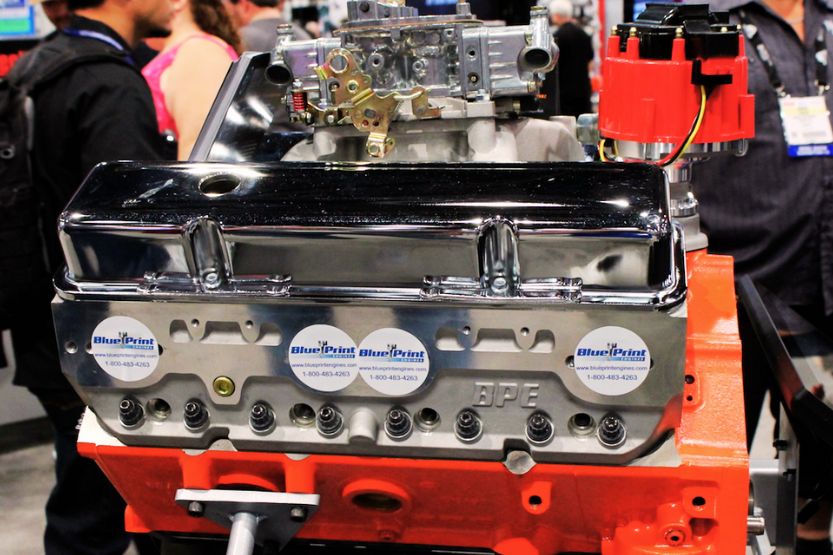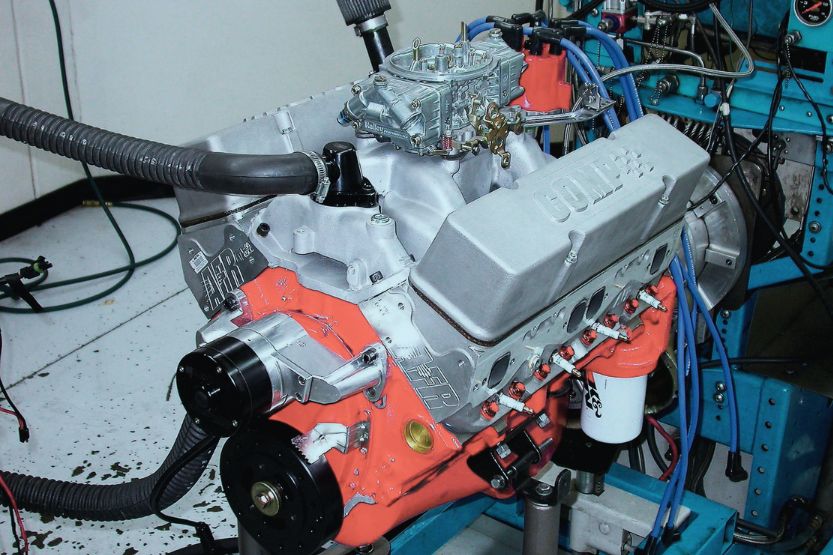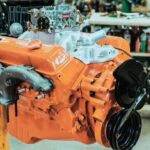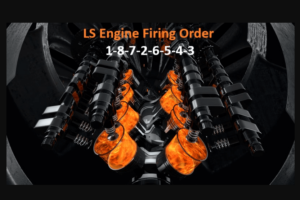Is it still worth installing a Small Block Chevy 400 engine in your car? Take note that this engine is almost 50 years old. So the question is will it be able to hold its own against more modern engines? What are the Small Block Chevy 400 specs, and what are gearheads saying about it now?
The Small Block Chevy 400 has an engine displacement of 400 cubic inches, capable of up to 265 horsepower when kept in stock condition. The SBC400 first came out in the 1970s. The original intention was to be a low-performance/high-torque engine since it is intended for light-duty trucks and heavier passenger cars.
Read on to learn more regarding the Small Block Chevy 400 specs and what people say about this classic engine.
Small Block Chevy 400 Specs

The small block Chevy engine remained virtually unchanged throughout its entire production run from 1954 until 2003. There have been a couple of improvements, but Chevy did not drastically change the engine’s original design:
1. Physical Dimensions
Same Dimensions as Previous and Succeeding Small Block Engines
The SBC 400 has the same dimensions as previous and succeeding small block engines. The engine measures around 28″ x 26″ x 27″. However, it managed to increase its displacement by modifying the internal dimensions.
Interchangeable with Other Chevrolet Engines
Due to having the same measurements, it made the SBC 400 made it easily interchangeable with other Chevrolet engines.
You can swap out the SBC 350 with an SBC 400 without needing modifications. The SBC 400 used the same ignition system as the other smaller displacement engines in the Chevy line.
This interoperability made the small block engines from Chevy, not just the SBC 400, a favorite choice for hot rodders. They used the same distributors, air intakes, exhaust systems, and other accessories. Even the weights of the small block engines are pretty similar at around 575 pounds each.
2. Internal Dimensions
The small block Chevy 400 looks like the others from the outside, but its internal dimensions are entirely different. General Motors’ research and development team had to think out of the box to reach its full potential.
Increased Bore
To achieve the 400 cubic inch displacement, the SBC 400 had an increased bore of 4.125 inches. It also lengthened the stroke to 3.75 inches. This allowed the engine to reach a displacement of over 400.9 cubic inches.
Same Block Size as the Other Small Block Engines
The block is the same size as the other small block engines. However, GM had to create a separate cast just for the SBC 400, so it could reach its intended displacement.
Redesigned Crankshaft
To achieve an extra 1/8-inch for the bore diameter, GM designers also eliminated the water jackets shared by adjacent cylinders. The crankshaft of the SBC 400 also got a redesign. The main journals were larger at 2.65 inches compared to the journals of the SBC 350, which is 2.65 inches.
Shorter Connecting Rods
The connecting rods in the SBC 400 were much shorter than the other Chevy small blocks. The usual connecting rods were 5.7 inches, while those in the SBC 400 were just 5.565 inches.
The shorter connecting rod and a longer stroke meant the engine would vibrate quite a lot. This made GM designers use external balancing methods, namely a flywheel/flexplate and a harmonic balancer. This is also what GM did for the 454 CID.
3. Power Output
GM originally intended the SBC 400 to be a low RPM and high torque engine because of its long stroke. Dealers also offered this to go with either a two-barrel or four-barrel carburetor option.
Before the 1970s, manufacturers measured the power output of their engines based on gross engine power instead of net power. This was measured from the drive wheels. That said, the SBC 400 had a gross horsepower rating of 265 horsepower and a net rating of 150 horsepower.
History of the SBC 400
Debuted in 1970
The SBC 400 is the only small block engine in the Chevrolet V8 line. It debuted in 1970 and went into production for ten years. It was loosely based on the prior SBC 350 but had a larger bore and stroke.
Installed in the Full-size Chevy and GMC Trucks
GM installed the SBC 400 in the full-size Chevy and GMC trucks. These include the K5 Blazer, the ½-, ¾-, and 1-ton trucks.
It was also used in the larger medium-duty trucks, although it was just an option and did not come standard. Aside from trucks, the SBC 400 was also in the mid-size A-body and full-size B-body GM cars until 1976.
Initial Power Output
The SBC 400 differs from the other small block Chevy engines as it uses a 2.65-inch large journal. It often has one more freeze plug on both sides of the engine block. The initial output of the 400 was 265 horsepower and only came with a 2-barrel carburetor.
GM Introduced a Four-barrel Carburetor in 1974
In 1974, GM introduced a four-barrel carburetor for the SBC 400. They also discontinued the two-barrel carb the following year. In 1976, Chevrolet launched the last passenger car using the SBC 400 engines.
Although the SBC 400 was quite popular with track racers, it was prone to cooling problems. This happens if the cylinder heads do not have steam holes. Also, because of the design of the block, the two-bolt main engines can produce more power than the four-bolt versions.
383 Stroker Engine
Right after the launch, hot rodders immediately installed the SBC 400’s long-stroke crankshafts into the engine block of the SBC 350. It then became the 383 stroker engine. The name came from the longer stroke of the SBC 400’s crankshaft.
The SBC 350 still had the water jackets between the cylinders. This is why the 383 stroker did not have the same cooling issues that the SBC 400 had.
The 383 stroker was not an official GM factory option. However, GM promptly offered a 383-crate motor in their performance catalog because it became popular.
Again, how much horsepower does a Chevy 400 small block have? A Small Block Chevy 400, which first came out in the 1970s and was intended for light-duty trucks and heavier passenger cars, can reach manage 401 hp and 458 lb-ft of torque.
What Is the Firing Order for a Small Block Chevy?
What Is the Difference Between the SBC 400 and 350?

As mentioned earlier, the SBC 400 and 350 are almost identical in design. This is why nearly all of their accessories are interchangeable. If you are in the junkyard, how can you distinguish between the SBC 400 and 350?
1. Casting Numbers
Check the engine block or the head. Car manufacturers must stamp identification numbers on the engine to help identify every unit, called the engine casting number. If you cannot read the numbers, use a bit of degreaser. Scrub it with a wire brush to clear it up.
In all SBC 400 engines, there are three unique numbers, namely 330817, 3951509, and 3951511. The engines with the 1511 casting numbers come with four-bolt mains. Meanwhile, the 0817 and 1509 engines come with 2-bolt mains.
The engines with two-bolt mains contain a lot more nickel in their webbing compared to the four-bolt engine blocks. This means the SBC 400 is a lot more durable than the 350.
2. Head Gaskets
Due to the cylinders on the SBC 400 being siamesed to achieve the required displacement, it needed steam holes and heads. In addition, it also needed head gaskets to reduce cooling system hot spots over the siamesed cylinders.
If an SMC 400 used the same heads or head gasket as the 350, it would overheat quickly. This will eventually cause severe damage to the engine.
3. Flexplate and the Inch Bore Spacing
The SBC 400 engines have larger bores and a longer stroke than the 350. The bore of the 400 is 4.125 inches, which is larger than the 350’s 4-inch bore. The 350 has a stroke length of 3.48 inches while the 400’s is 3.75 inches.
Moreover, the crankshaft of the SBC 400 had a diameter measuring 2.65 inches and was balanced externally. On the other hand, the 350 had 2.45-inch in diameter.
Advantages and Disadvantages of the SBC 400
Advantages
1. Lightweight
One of the most significant advantages of the SBC 400 is that it is significantly lighter compared to big block engines. Despite having 400 cubic inches of displacement, this engine still managed to keep the compact size of small block engines.
This is why the SBC 400 became quite popular with racers. When building a drag racing car, you will want all the components to be as light as possible. This includes the engine, making the SBC 400 the perfect choice for this application.
2. Long Stroke
As mentioned repeatedly, the SBC 400 has a longer stroke than the 350. When it comes to engines, the longer the stroke, the more power it can produce. In addition, the amount of low-end torque that this engine can produce is also incredible.
This is important because you will need this low-end torque when building a race car. This allows the engine to reach its peak horsepower quicker. It will also transfer all that power to the wheels.
3. Huge Tuning Potential
Because of the improved engine internals of the Small Block Chevy 400, it is prime for tuning. You can unlock additional horsepower sleeping in the engine by installing high-performance cylinder heads, aftermarket performance camshafts, and other components.
It was mentioned earlier that hot rod builders in the 70s swapped the parts of the SBC 400 and 350. This is to create the iconic 358 stroker engine.
Disadvantages
1. Availability
If you are looking for an original SBC 400 in good condition, you’re up for a long and expensive hunt.
Gearheads know the value of the 400, and they will go to any lengths to get their hands on them. Because of the huge tuning potential, people are snatching these engines up as soon as they hit junkyards.
The chances of you finding a running condition SBC 400 from junkyards are slim to none. You can buy them directly from collectors or savvy scrappers who got them first from junkyards. However, expect to pay a hefty price.
2. Mediocre Stock
When left as stock, 400 SBC engines are not that great. To truly unlock the full potential of this engine, you should throw a bit more money at it. For instance, you must replace the heads and camshaft with aftermarket performance parts.
Also, these engines in a stock configuration are pretty bad when it comes to performance. Their heads are the limitation for unlocking the power that you want.
The stock heads produce low-end torque and lots of pulling power. This is why it was initially in the small and medium Chevy trucks.
3. Requires Balancers
Another disadvantage of the SBC 400 is its long stroke and bore, making the engine produce vibrations. This means it will need balancers on both sides of the block. This can be pretty annoying for Chevy users who hate using those accessories.
What Is the Difference Between a Small Block and a Big Block Engine?
Why is the SBC 400 called a “small block”? Which one is the better choice? Also called overhead valve engines, small and big block engines describe Chevrolet’s V8 engines.
1. Size
As the name suggests, the big block engines are considerably bigger than the small ones. However, even though they are small block engines, they are still quite massive hunks of metal.
2. Engine Displacement
Aside from the physical size, other things that differentiate the SBC 400 from the 350 include engine displacement. These also include the bore and stroke ratio.
Big block engines’ displacements are usually over 400 cubic inches. Meanwhile, small block engines are 400 cubic inches and below. With this said, the SBC 400 has the biggest displacement of all the small block engines. It has the same displacement as base big block engines.
However, these are not the definitive meanings of small and big block engines. The reason is that nothing in the automotive industry is quite straightforward.
For instance, the manner of mounting the engines’ valves and the cylinders’ arrangement cause some engines to have enormous displacements. Despite that, they are still small block engines.
3. Handling, Acceleration, and Torque
Big and small block engines both have advantages and disadvantages. Your choice will depend largely on what you want to do with the engine.
Small block engines weigh significantly less than big blocks. This gives them an advantage when it comes to handling and acceleration. However, big block engines can produce more torque, which somewhat negates the disadvantages of their weight.
There is no “better” choice between small and big block engines. Just choose based on whatever end goal you have for your car. To a certain extent, you can also consider the vehicle’s weight. You need to choose the right engine for whatever job you have in line for it.
Frequently Asked Questions (FAQs)
Is the Chevy 400 A Big Block Engine?
Despite having the same displacement as a low-end big block Chevy motor, the SBC 400 is a small block engine. It is exactly the same size as the Chevy 350.
What Is the Biggest Problem That the SBC 400 Had?
There are a couple of common issues that are quite serious. These include stress cracks on the cylinder heads and overheating issues due to the siamesed cylinders.
What Are Siamesed Cylinders?
Siamesed cylinders are arranged so there are no channels between them for coolant to flow through. You can see it being done on the SBC 400. This is to increase the bore size without having to increase the size of the engine block.
However, the issue with siamesed cylinders is that they are prone to overheating. The main reason is that there is insufficient coolant passing through the engine.
However, hot rodders found a workaround by machining steam holes in the head. By doing that, there will be a way for the heat to vent.
In Closing – Small Block Chevy 400 Specs and Reviews
As the name suggests, the Small Block Chevy 400 has a displacement of 400 cubic inches. It can also produce up to 265 horsepower in its stock configuration. The SBC 400 first came out in the early 1970s.
GM was also initially designed for Chevy’s pickup trucks and heavy passenger cars. However, its capability to produce massive amounts of torque at low RPMs made it an immediate favorite among racers.
Nowadays, it is almost impossible for a regular person to get his hands on a mint-condition SBC 400. If you find one, expect to spend a ton of money if you plan to buy it.
This engine may not be the most powerful that GM has ever made. However, its high potential for tuning makes it highly sought after.
Read next:

![Chevy 350 Firing Order [V8 Big Block, Small Block, 5.3, 5.7] chevy 350 firing order](https://roadsumo.com/wp-content/uploads/2021/07/chevy-350-firing-order-150x150.jpg)





![Read more about the article 5.7 Hemi Problems [7 Most Common]](https://roadsumo.com/wp-content/uploads/2021/11/5.7-Hemi-Problems-300x200.jpg)

